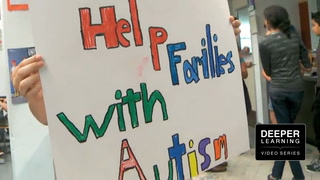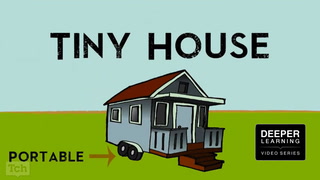Kathleen Cushman on Student Motivation Transcript
Card: Tch Teaching Channel
In Partnership with The William and Flora Hewlett Foundation
Card: High Tech High
Expert commentary by:
Kathleen Cushman
Lower Third: Kathleen Cushman
WKCD.org
Author, "The Motivation Equation"
+++ 00:00:11 +++
Kathleen Cushman: My name is Kathleen Cushman, and I've been documenting the learning of adolescents for over 25 years. What's really fascination to me in my own research over the last four years or more with what kids can do is I'm thinking about adolescent motivation and mastery. And I'm going directly to students to ask them their own experiences, and then I'm lining up with the people on the opposite end of the spectrum, the learning scientists who have spent their professional lives figuring out really in detail
+++ 00:00:45 +++
what goes on when somebody is learning. Building agency in adolescents is the thing that they're supposed to be doing. So at High Tech High, adults and students are collaborating all the time on things that matter to everybody. And students are given a lot of room to run with that, and to make public products and to really act like developing adults. The other main thing that High Tech High does is it offers students a huge amount of choice in how they do that. And of
+++ 00:01:15 +++
course, that's connected to agency. And when people have choice in what they do, they value it, right? So at High Tech High, they choose it, and they also expect that they can succeed at it. So they have these two value and expectation of success factors, which gives them the motivation, and then they have this sense that they are developing adults, doing something that matters in the adult world. And that gives them a sense of real pride and agency. We saw sixth graders, for example, at High Tech Middle, doing research on
+++ 00:01:48 +++
coastal pollution. Well, I've seen projects like this in a lot of different schools. This is not an unusual project for students to do in school. And they're out there in their community, and they're documenting things, and they're making their little bracelets and selling it for the good of others. What's so important about this is that they have to use it. That's one of the eight conditions of really being a learner. Number one, they have to feel okay; two, it has to matter to them; three, it has to be active in some way; four, it
+++ 00:02:18 +++
has to stretch them in some way; that means, five, they need a coach; and six, then they have to use it. You can't just learn how to do something. You have to use it. After you use it, you have to think back on it and reflect on it, and finally, you have to plan your next steps. Those conditions, if they didn't have to really use it in some way, they could study all the coastal pollution they wanted and it would matter to them. Also, it matters to these kids, because they live at the seaside, and they both said they go surfing! But now look at those same students when
+++ 00:02:53 +++
they're later in high school, and they're doing something really astonishing, which is to take the question of environmental science and build this tiny house all by themselves, and call in a contractor to teach them how to do it, so it's active, they're using it, but they're really using it to prove a point. If you start that way in sixth grade, then by twelfth grade, they will really be doing things that they take obvious pride in. The wonderful thing about High Tech High is that teachers are collaborating with each other across the disciplines. That teachers are doing
+++ 00:03:26 +++
that and students are watching them do that, and then students are doing that. So students become collaborators with adults in the High Tech High system. And you see that very clearly. There's a very clear tone of respect for students' contributions, for their work, for their critique, for their revisions, and for their presentations. The English/Language Arts standards, Anchor standards, and Common Core, and the mathematical standards of Common Core all have to do
+++ 00:03:59 +++
with really going into something independently, taking on problems independently, making them your own, making something with them, presenting them to others, critiquing them, revising them, making sure they're very precise and accurate. The arts projects at High Tech High are a perfect example of this. They cross the disciplines. And when you look at that you see all kinds of precision, and all kinds of deep understanding of friction and physics and engineering.
+++ 00:04:36 +++
But also an understanding of presentation, and an understanding of impact on audience, which all of these standards really want. Because put it this way, in 21st Century, all 21st Century standards have to do with communicating what you know and can do.
Card: Tch Teaching Channel
In Partnership with The William and Flora Hewlett Foundation
#### End of CUSH_HTHTS.m4v ####














6 Comments
melissa hollis Mar 7, 2020 8:30pm
The link between agency in the work that the arts projects generate and the ability to critique is spot on. Very interesting work.
Christina Parotidou Feb 1, 2015 10:31pm
tom jackson Aug 4, 2014 10:27am
barbara uebing Aug 4, 2014 7:22am
shabeer khan Jul 22, 2014 6:26am